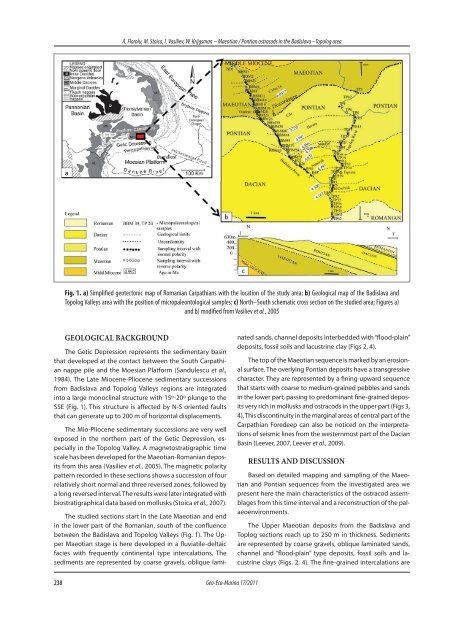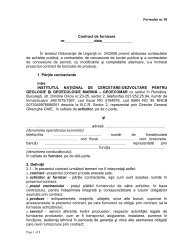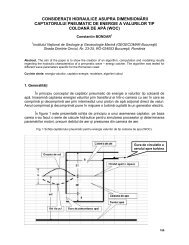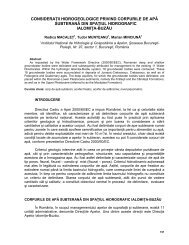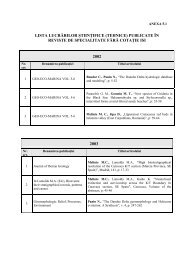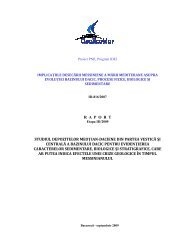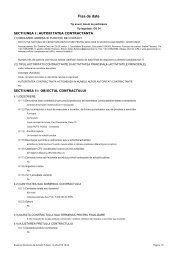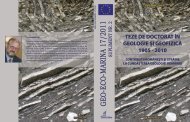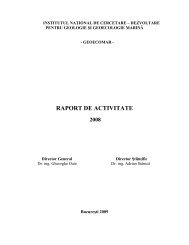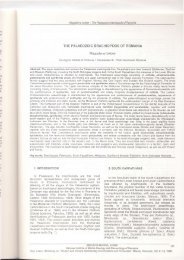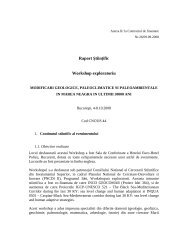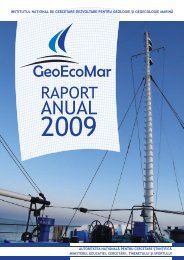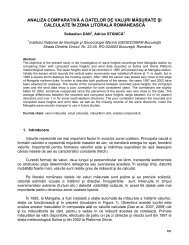Maeotian / Pontian ostracods in the Badislava ... - GeoEcoMar
Maeotian / Pontian ostracods in the Badislava ... - GeoEcoMar
Maeotian / Pontian ostracods in the Badislava ... - GeoEcoMar
You also want an ePaper? Increase the reach of your titles
YUMPU automatically turns print PDFs into web optimized ePapers that Google loves.
A. Floroiu, M. Stoica, I. Vasiliev, W. Krijgsman – <strong>Maeotian</strong> / <strong>Pontian</strong> <strong>ostracods</strong> <strong>in</strong> <strong>the</strong> <strong>Badislava</strong> –Topolog area<br />
Fig. 1. a) Simplified geotectonic map of Romanian Carpathians with <strong>the</strong> location of <strong>the</strong> study area; b) Geological map of <strong>the</strong> <strong>Badislava</strong> and<br />
Topolog Valleys area with <strong>the</strong> position of micropaleontological samples; c) North–South schematic cross section on <strong>the</strong> studied area; Figures a)<br />
and b) modified from Vasiliev et al., 2005<br />
Geological background<br />
The Getic Depression represents <strong>the</strong> sedimentary bas<strong>in</strong><br />
that developed at <strong>the</strong> contact between <strong>the</strong> South Carpathian<br />
nappe pile and <strong>the</strong> Moesian Platform (Sandulescu et al.,<br />
1984). The Late Miocene-Pliocene sedimentary successions<br />
from <strong>Badislava</strong> and Topolog Valleys regions are <strong>in</strong>tegrated<br />
<strong>in</strong>to a large monocl<strong>in</strong>al structure with 15 o -20 o plunge to <strong>the</strong><br />
SSE (Fig. 1). This structure is affected by N-S oriented faults<br />
that can generate up to 200 m of horizontal displacements.<br />
The Mio-Pliocene sedimentary successions are very well<br />
exposed <strong>in</strong> <strong>the</strong> nor<strong>the</strong>rn part of <strong>the</strong> Getic Depression, especially<br />
<strong>in</strong> <strong>the</strong> Topolog Valley. A magnetostratigraphic time<br />
scale has been developed for <strong>the</strong> <strong>Maeotian</strong>-Romanian deposits<br />
from this area (Vasiliev et al., 2005). The magnetic polarity<br />
pattern recorded <strong>in</strong> <strong>the</strong>se sections shows a succession of four<br />
relatively short normal and three reversed zones, followed by<br />
a long reversed <strong>in</strong>terval. The results were later <strong>in</strong>tegrated with<br />
biostratigraphical data based on mollusks (Stoica et al., 2007).<br />
The studied sections start <strong>in</strong> <strong>the</strong> Late <strong>Maeotian</strong> and end<br />
<strong>in</strong> <strong>the</strong> lower part of <strong>the</strong> Romanian, south of <strong>the</strong> confluence<br />
between <strong>the</strong> <strong>Badislava</strong> and Topolog Valleys (Fig. 1). The Upper<br />
<strong>Maeotian</strong> stage is here developed <strong>in</strong> a fluviatile-deltaic<br />
facies with frequently cont<strong>in</strong>ental type <strong>in</strong>tercalations. The<br />
sediments are represented by coarse gravels, oblique lam<strong>in</strong>ated<br />
sands, channel deposits <strong>in</strong>terbedded with “flood-pla<strong>in</strong>”<br />
deposits, fossil soils and lacustr<strong>in</strong>e clay (Figs 2, 4).<br />
The top of <strong>the</strong> <strong>Maeotian</strong> sequence is marked by an erosional<br />
surface. The overly<strong>in</strong>g <strong>Pontian</strong> deposits have a transgressive<br />
character. They are represented by a f<strong>in</strong><strong>in</strong>g-upward sequence<br />
that starts with coarse to medium-gra<strong>in</strong>ed pebbles and sands<br />
<strong>in</strong> <strong>the</strong> lower part, pass<strong>in</strong>g to predom<strong>in</strong>ant f<strong>in</strong>e-gra<strong>in</strong>ed deposits<br />
very rich <strong>in</strong> mollusks and <strong>ostracods</strong> <strong>in</strong> <strong>the</strong> upper part (Figs 3,<br />
4). This discont<strong>in</strong>uity <strong>in</strong> <strong>the</strong> marg<strong>in</strong>al areas of central part of <strong>the</strong><br />
Carpathian Foredeep can also be noticed on <strong>the</strong> <strong>in</strong>terpretations<br />
of seismic l<strong>in</strong>es from <strong>the</strong> westernmost part of <strong>the</strong> Dacian<br />
Bas<strong>in</strong> (Leever, 2007, Leever et al., 2009).<br />
Results and discussion<br />
Based on detailed mapp<strong>in</strong>g and sampl<strong>in</strong>g of <strong>the</strong> <strong>Maeotian</strong><br />
and <strong>Pontian</strong> sequences from <strong>the</strong> <strong>in</strong>vestigated area we<br />
present here <strong>the</strong> ma<strong>in</strong> characteristics of <strong>the</strong> ostracod assemblages<br />
from this time <strong>in</strong>terval and a reconstruction of <strong>the</strong> palaeoenvironments.<br />
The Upper <strong>Maeotian</strong> deposits from <strong>the</strong> <strong>Badislava</strong> and<br />
Toplog sections reach up to 250 m <strong>in</strong> thickness. Sediments<br />
are represented by coarse gravels, oblique lam<strong>in</strong>ated sands,<br />
channel and “flood-pla<strong>in</strong>” type deposits, fossil soils and lacustr<strong>in</strong>e<br />
clays (Figs. 2, 4). The f<strong>in</strong>e-gra<strong>in</strong>ed <strong>in</strong>tercalations are<br />
238 Geo-Eco-Mar<strong>in</strong>a 17/2011


